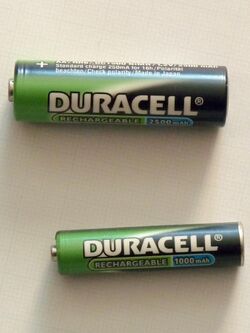Ampere hour
| ampere hour | |
|---|---|
 Rechargeable batteries Top: AA battery (2500 mA⋅h) Bottom: AAA battery (1000 mA⋅h) | |
| General information | |
| Unit system | Non-SI metric unit |
| Unit of | Electric charge |
| Symbol | A⋅h |
| Conversions | |
| 1 A⋅h in ... | ... is equal to ... |
| SI units | 3600 C |
| Electrostatic units | 1.079253×1013 statC |
| Electromagnetic units | 360 abC |
| Gaussian units | 1.079253×1013 Fr |
An ampere hour or amp hour (symbol: A⋅h or A h; often simplified as Ah) is a unit of electric charge, having dimensions of electric current multiplied by time, equal to the charge transferred by a steady current of one ampere flowing for one hour, or 3,600 coulombs.[1][2]
The commonly seen milliampere hour (symbol: mA⋅h, mA h, simplified as mAh) is one-thousandth of an ampere hour (3.6 coulombs).
Use
The ampere hour is frequently used in measurements of electrochemical systems such as electroplating and for battery capacity where the commonly known nominal voltage is dropped.
A milliampere second (mA⋅s) is a unit of measurement used in X-ray imaging, diagnostic imaging, and radiation therapy. It is equivalent to a millicoulomb. This quantity is proportional to the total X-ray energy produced by a given X-ray tube operated at a particular voltage.[3] The same total dose can be delivered in different time periods depending on the X-ray tube current.
To help express energy, computation over charge values in ampere hour requires precise data of voltage: in a battery system, for example, accurate calculation of the energy delivered requires integration of the power delivered (product of instantaneous voltage and instantaneous current) over the discharge interval.[4] Generally, the battery voltage varies during discharge; an average value or nominal value may be used to approximate the integration of power.[5]
Other measures of electric charge
The Faraday constant is the charge on one mole of electrons, approximately equal to 26.8 ampere hours. It is also used in electrochemical calculations.
Examples
- An AA size dry cell has a capacity of about 2,000 to 3,000 milliampere hours.
- An average smartphone battery usually has between 2,500 and 4,000 milliampere hours of electric capacity.
- Automotive car batteries vary in capacity but a large automobile propelled by an internal combustion engine would have about a 50-ampere-hour battery capacity.
- Since one ampere hour can produce 0.336 grams of aluminium from molten aluminium chloride, producing a ton of aluminium required transfer of at least 2.98 million ampere hours.[6]
See also
References
- ↑ "electric charge (Symbol Q). IEV 113-02-10". International Electrotechnical Commission (IEC). 2020. http://www.electropedia.org/iev/iev.nsf/display?openform&ievref=113-02-10. "Note 7 to entry: The coherent SI unit of electric charge is coulomb, C. The unit ampere hour is used for electrolytic devices, such as storage batteries: 1 A·h = 3,6 kC."
- ↑ Thompson, Ambler; Taylor, Barry N. (2008). Guide for the Use of the International System of Units (SI). NIST Special Publication 811 (2nd ed.). Gaithersburg: National Institute of Standards and Technology. p. 45. https://nvlpubs.nist.gov/nistpubs/Legacy/SP/nistspecialpublication811e2008.pdf. "To convert from ampere hour (A·h) ... to coulomb (C) ... Multiply by 3.6 E+03"
- ↑ X-ray Safety Handbook, 9.0 Terms and Definitions, VirginiaTech Environmental, Health and Safety Services
- ↑ Efty Abir, Najrul Islam (2016). "How to Calculate Amp Hours – Learn of Convert Watts to Amps". Leo Evans. http://trollingpowersolution.com/how-to-calculate-amp-hours/.
- ↑ National Research Council (U.S.) (2004). Meeting the energy needs of future warriors. National Academies Press. p. 27. ISBN 0-309-09261-2.
- ↑ T. L. Brown, H. E. Lemay Jr, "Chemistry the Central Science", Prentice-Hall, 1977 ISBN:0-13-128769-9 page 562

